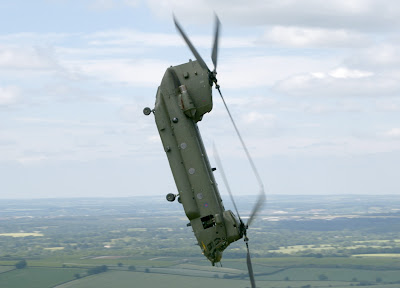The RAF operates the largest fleet of Chinook Support Helicopters after the US Army, with a total of 34 HC2s, 6 HC2As and 8 HC3s (the HC3 has yet to enter operational service). The Chinook Wing, which forms the heavy-lift element of the Joint Helicopter Command (JHC), is based at RAF Odiham in Hampshire. Odiham supports three operational squadrons, No 7 Squadron, No 18 Squadron and No 27 Squadron, and the Operational Conversion Flight.
The Chinook HC2 Helicopter and Chinook HC2A Helicopter are used primarily for trooping and for carrying internal and/or underslung loads and can carry up to 55 troops or 10 tonnes of freight. The cabin is large enough to accommodate two Landrovers, while the three underslung load hooks allow a huge flexibility in the type and number of loads that can be carried externally. Secondary roles include search and rescue and casualty evacuation, in which role a total of 24 stretchers can be carried. The crew consists of either two pilots, or a pilot and a weapons systems officer (WSO), and two air loadmasters.
The pilot captain is responsible for the safe operation of the aircraft and completion of the mission, while the co-pilot or WSO operates the mission-management systems, navigation, communications and the self-defence suite. In the cabin are two air loadmasters who are responsible for passenger safety, load or cargo restraint, weapons operation and voice marshalling of the aircraft.
The Chinook Helicopter are well equipped for their varied roles and are fitted with a satellite Global Positioning System, an Instrument Landing System, comprehensive avionics that enable them to fly in airways, and an extensive radio suite. The aircraft cockpit has a full night-time capability when operated with night-vision goggles, thus allowing low-level night operations in a hostile environment. The aircraft also carries dualmode landing lights that can be switched between white and Infrared light, which are supported by Infrared searchlights operated by the two crewmen. The Chinook is well equipped with defensive aids and has a Radar Warning Receiver, an Ultraviolet and Doppler Missile Approach Warning System, Infrared Jammers and chaff and flare dispensers, which can be manually or automatically fired. The aircraft can be armed with two M134 six-barrelled Miniguns, one in each front side window, and an M60D machine gun on the ramp.
The Chinook is a very capable and versatile support helicopter that can be operated in many diverse
environments ranging from cold weather ‘arctic’ conditions to desert warfare operations. It has been
involved in most of the recent UK Operations such as the Falklands Conflict, Northern Ireland, the Gulf War, peace keeping in Bosnia, Kosovo operations, evacuation of Sierra Leone, operations in Afghanistan and, more recently, in Iraq.
Chinook Helicopter Specifications
Powerplant: Two Textron Lycoming T55-L712F turboshafts
Thrust: 3750shp each
Length: 30.18m (99ft)
Fuselage length: 15.54m (51ft)
Height: 5.78m (18ft 11ins)
Rotor diameter: 18.29m (60ft)
Endurance: 23/4hrs internal tanks
Max T/O weight: 24,500kg (53,900lbs)
Max airspeed: 160kts (185mph)
Max altitude: 15,000ft

















0 comments:
Post a Comment